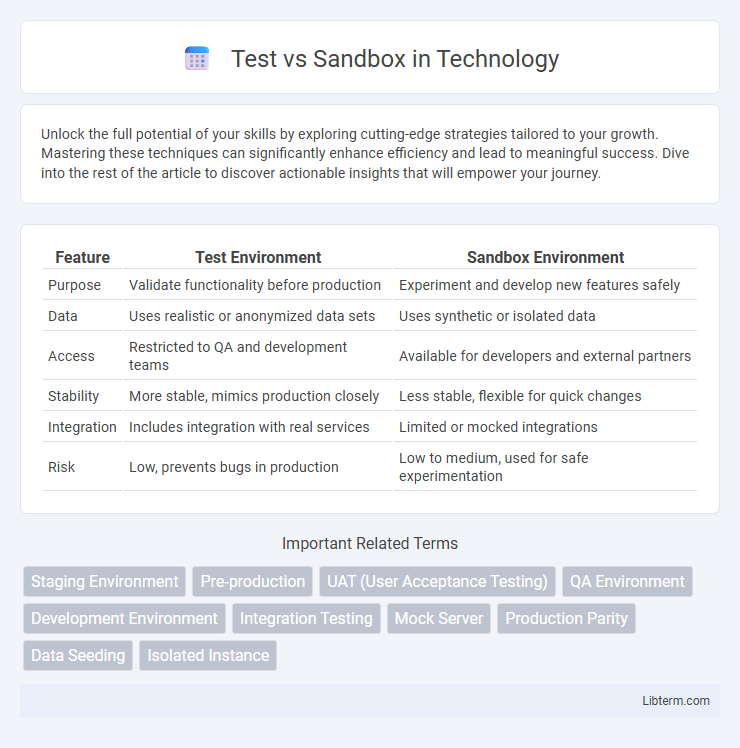Unlock the full potential of your skills by exploring cutting-edge strategies tailored to your growth. Mastering these techniques can significantly enhance efficiency and lead to meaningful success. Dive into the rest of the article to discover actionable insights that will empower your journey.
Table of Comparison
| Feature | Test Environment | Sandbox Environment |
|---|---|---|
| Purpose | Validate functionality before production | Experiment and develop new features safely |
| Data | Uses realistic or anonymized data sets | Uses synthetic or isolated data |
| Access | Restricted to QA and development teams | Available for developers and external partners |
| Stability | More stable, mimics production closely | Less stable, flexible for quick changes |
| Integration | Includes integration with real services | Limited or mocked integrations |
| Risk | Low, prevents bugs in production | Low to medium, used for safe experimentation |
Introduction to Test and Sandbox Environments
Test environments replicate production settings to validate software functionality and performance under controlled conditions, ensuring reliability before deployment. Sandbox environments provide isolated spaces for developers to experiment, troubleshoot, and develop new features without risking disruption to live systems. Both environments are essential for minimizing errors and improving software quality by enabling safe and effective testing workflows.
Defining the Test Environment
A test environment is a controlled setup where software applications are executed to verify functionality, detect defects, and ensure quality before deployment. Unlike a sandbox, which isolates code changes for experimentation and development without affecting the main system, the test environment mimics production conditions to validate performance under real-world scenarios. Key components of a test environment include hardware, software, network configurations, and test data closely resembling actual user data.
What is a Sandbox Environment?
A sandbox environment is an isolated testing space that allows developers to experiment with code, configurations, and applications without affecting live systems or production data. It replicates key elements of the production environment to closely mimic real-world scenarios while maintaining complete safety and control. This controlled environment helps detect bugs, verify functionality, and test integrations before deployment.
Key Differences Between Test and Sandbox
Test environments simulate real-world conditions for validating software functionality and performance, enabling thorough debugging without affecting production data. Sandbox environments provide isolated spaces for experimenting with new code, configurations, or integrations, ensuring no risk to live systems or existing workflows. Key differences include purpose--testing for quality assurance versus sandboxing for safe innovation--and data handling, where test environments may use partial or anonymized production data, while sandboxes typically operate with synthetic or development data sets.
Use Cases for Test Environments
Test environments are essential for validating application functionality before production deployment, enabling developers to identify and resolve bugs in a controlled setting. These environments facilitate integration testing, performance testing, and user acceptance testing, ensuring software stability and reliability. Test environments replicate production conditions closely, allowing for accurate simulation of real-world scenarios without impacting live users.
When to Use a Sandbox Environment
A sandbox environment is essential when developers need a secure, isolated space to experiment with new code, configurations, or integrations without impacting live production data or systems. It is ideal for testing functionality, debugging, and validating changes during early development stages to prevent risks and ensure system stability. Using a sandbox environment reduces errors and enhances deployment confidence by allowing comprehensive quality assurance before production rollout.
Security Implications: Test vs Sandbox
Test environments often mimic production systems but run on separate infrastructure to limit risk exposure, ensuring vulnerable code doesn't affect live data. Sandbox environments isolate applications completely, providing a secure space for executing untrusted code without risking system integrity or sensitive information. The strict separation and containment in sandboxes mitigate threats like data leaks, malware execution, and unauthorized access more effectively than typical test setups.
Best Practices for Managing Test and Sandbox
Implement strict access controls and maintain separate environments to ensure data integrity and security in both test and sandbox setups. Regularly refresh sandbox data to mirror production environments accurately while anonymizing sensitive information to comply with privacy regulations. Implement automated testing frameworks and continuous integration processes to streamline deployment and catch issues early in the development cycle.
Common Challenges and Solutions
Test and Sandbox environments often face challenges such as data synchronization issues, limited access to real-time production data, and configuration inconsistencies that can lead to inaccurate testing results. Implementing automated data refresh cycles, using mock services or synthetic data, and maintaining version-controlled environment configurations help mitigate these problems. Ensuring continuous integration and environment parity between test and sandbox setups enhances reliability and reduces deployment risks.
Choosing the Right Environment for Your Needs
Choosing the right environment between Test and Sandbox depends on the project's goals and risk tolerance. Test environments provide controlled, stable setups for verifying functionality with realistic data, ideal for final validation before production release. Sandbox environments offer flexible, isolated spaces for experimentation and development, allowing developers to try new features without impacting live systems.
Test Infographic

 libterm.com
libterm.com